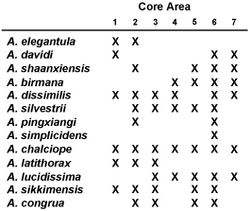Amara pingshiangi
| Notice: | This page is derived from the original publication listed below, whose author(s) should always be credited. Further contributors may edit and improve the content of this page and, consequently, need to be credited as well (see page history). Any assessment of factual correctness requires a careful review of the original article as well as of subsequent contributions.
If you are uncertain whether your planned contribution is correct or not, we suggest that you use the associated discussion page instead of editing the page directly. This page should be cited as follows (rationale):
Citation formats to copy and paste
BibTeX: @article{Kavanaugh2014ZooKeys407, RIS/ Endnote: TY - JOUR Wikipedia/ Citizendium: <ref name="Kavanaugh2014ZooKeys407">{{Citation See also the citation download page at the journal. |
Genus: Amara
Name
Amara pingshiangi Jedlička, 1957 – Wikispecies link – Pensoft Profile
- Amara (Curtonotus) pingshiangi Jedlička, 1957: 24. Type material: Lectotype female in NMPC (Hieke 1990[1]: 238). Type locality: China, “Süd China: Pingshiang”, probably Jiangsu Province. Transferred to subgenus Bradytus by Hieke (1990[1]: 238).
Diagnosis
Adults of this species (Fig. 20) can be distinguished from those of all other species in the region by the following combination of character states: body length 11–13 mm, body form stout; dorsal surface dark piceous, at least femora and outer antennomeres dark (piceous to black); pronotum with lateral margin markedly rounded,pronotal base punctate, lateral areas in basal half and near anterior margin also punctuate in most specimens; elytra with parascutellar pore puncture absent; medial protibial spurs simple; tarsomere 5 of hind tarsi with five or six pairs of setae ventrally (Fig. 6a); last abdominal sternite of male with one pair (Fig. 5e) and female with two pairs (Fig. 5c) of setiferous punctures near hind margin.
Habitat distribution
Specimens of this species were collected only at night, active on the ground in marshy meadow margin areas (Fig. 25b) near forest edges, at elevations ranging from 1515 to 2010 m, and syntopic with adults of Amara birmana, Amara dissimilis and Amara shaanxiensis at one or more sites.
Geographical distribution within the Gaoligong Shan
Fig. 20d. We examined a total of 3 specimens (2 males and 1 female) from the following localities: Gongshan County: Cikai Township (27.74939°, 98.66453°, 1515 m, 25 Sep. 2002, H.B. Liang & W.D. Ba collectors [1 female; IOZ]). Tengchong County: Longtang He (at Dahetou Lingganjiao, 25.73947°, 98.6963°, 2010 m, 16 May 2006, D.H. Kavanaugh collector [1 male; CAS], 18 May 2006, D.H. Kavanaugh & R.L. Brett collectors [1 male; CAS]).
Members of this species were collected at only two sites, one in the northeastern part (Core Area 2) and other in the southwestern part (Core Area 6) of the study area, but not in intervening areas. This gap in distribution is most likely an artifact of inadequate sampling and not a real disjunction.
Overall geographical distribution
Fig. 27. This species has been recorded from Fujian, Jiangxi, Sichuan, Yunnan and Zhejiang Provinces in China. Its occurrence in the study area represents the western limit of its known geographical range.
Taxon Treatment
- Kavanaugh, D; Hieke, F; Liang, H; Dong, D; 2014: Inventory of the carabid beetle fauna of the Gaoligong Mountains, western Yunnan Province, China: species of the tribe Zabrini (Coleoptera, Carabidae) ZooKeys, 407: 55-119. doi
Other References
- ↑ 1.0 1.1 Hieke F (1990) Neue und wenig bekannte Amara-Arten aus Amerika und Asien (Coleoptera, Carabidae). Mitteilungen aus dem Zoologischen Museum Berlin 66: 195-292. doi: 10.1002/mmnz.19900660202
Images
|







